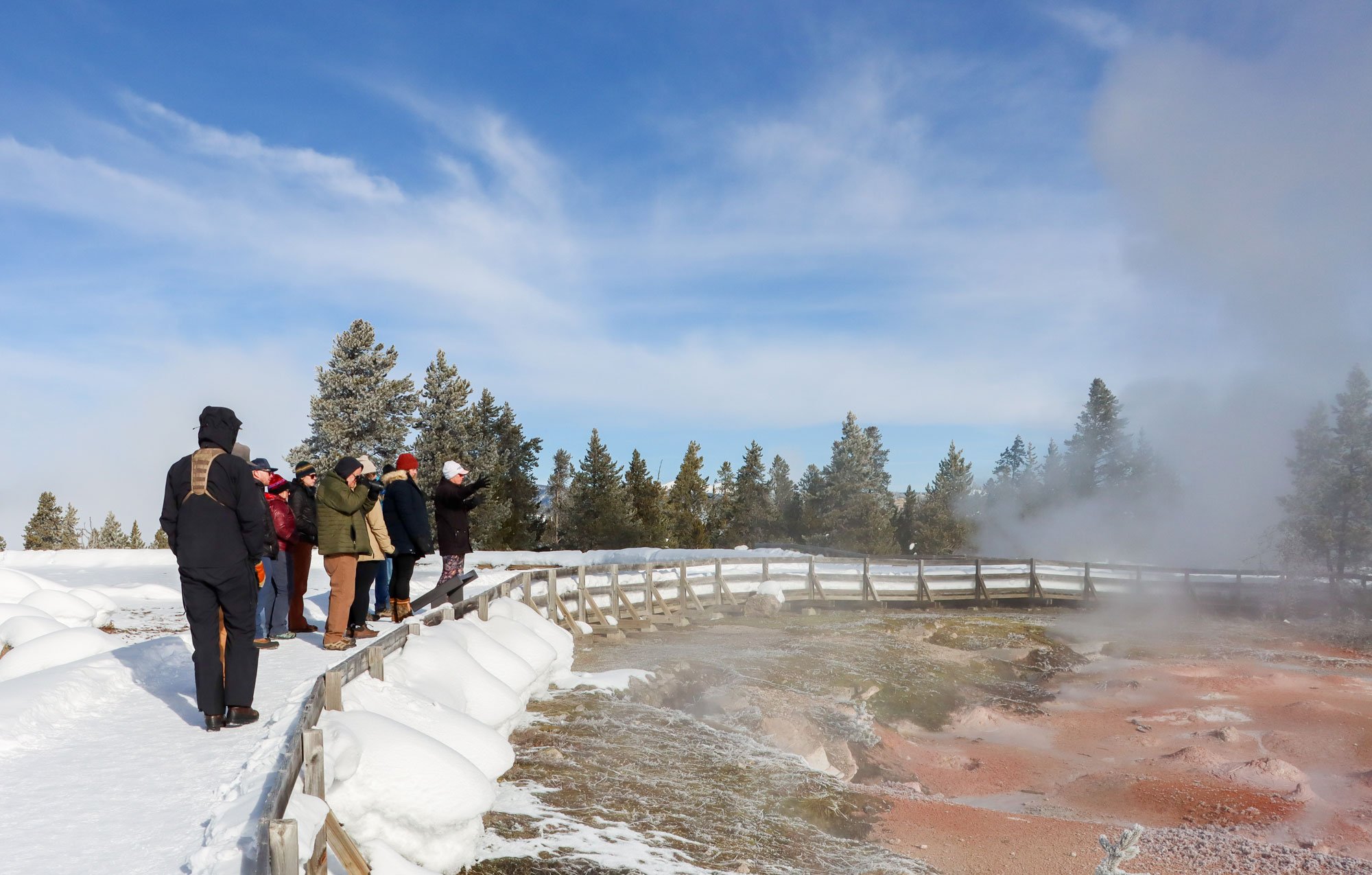A Day in Yellowstone With
Yellowstone Scenic tours
By Emma Heller
The Yellowstone Scenic Tours (YST) crew taking in the beautiful day and admiring Fountain Paint Pots at the Lower Geyser Basin.
Over the winter, many tour companies that operate in Yellowstone Park aren’t active, including Yellowstone Scenic Tours. Because of this, we don’t get to see our coworkers as often as we do over the summer. Many of our guides stay in Big Sky and have a winter-specific jobs in the area, while some move away for the season and come back each spring for the summer. We pride ourselves on offering a multi-day training each spring to refresh our knowledge, learn new information, and bring ourselves up-to-date on current affairs in Yellowstone. We often talk about how little we get into the Park in the winter and how some of us have never been on a snow coach tour. This year, our fearless leader and owner changed that, and we spent a sunshine-filled day in Yellowstone.
During the winter, Yellowstone doesn’t have the same access into the Park that it does in the summer. In the winter, the only road that is open goes from the North Entrance in Gardiner, Montana, to the North East Entrance in Cooke City, Montana. All other entrances, are open to snowmobile, snow coach travel or by cross country skis or snowshoes. Our guides will visit the North East section of the Park in the winter to wolf watch in Lamar Valley, head to Cooke City via the Park to backcountry ski or snowmobile, and one of our guides grew up in Gardiner! Visiting Yellowstone in the winter makes it feel like an entirely new Park. If you haven’t been to Yellowstone in the winter, we hope you can experience it someday. For now, we hope that sharing our experience with you will suffice!
Some of the YST team! Look at those tires on the snow coach!
We began our day in Big Sky, Montana, in the same fashion that many of our tours start. We met at the Wilson Hotel and loaded into the van with coffee and breakfast in hand. The drive to West Yellowstone, where our tour and snow coach awaited our arrival, was spent catching up with each other, and of course the friendly banter started as the coffee set in. Upon our arrival to West Yellowstone, it was clear the town was in a stage of hibernation, like many of the animals in the Park. Snow covered and quite it was a welcomed sight to see the usually busy town, taking a break. We met our guide for the day and all piled into a warm and comfy snow coach.
As we were driving in the Park, it was as if someone was turning up the dimmer switch of the sun. The further we made our way in, the brighter it became. It was like the sun was showing off Yellowstone and made for a grand entrance. The Madison River’s established route was surrounded by bright white snow highlighting the blue water. With temperatures often in the negatives during the winter, the Madison River was flowing steadily, without ice or snow. Unlike other rivers in the region, the Madison River has numerous thermal features that flow into it. The Firehole River, one of the Madison Rivers tributaries, has three major geyser basins' thermal water runoff that increases the water temperatures year-round. You could be tricked into thinking there were chunks of snow in the water from the trumpeter swans with their heads submerged feeding on the river bottom. Not long after entering the Park, we had our first bison jam of the day!
These ladies were unbothered by us stopping right next to them and driving by. This is their home!
Primarily bison, but other animals in the Park take advantage of the roads where the snow has been packed down by snowmobile and snow coach traffic. By using the roads, it makes it easier for the animals to travel throughout the Park and end up using less energy than trudging through feet of snow. While it was obvious that the bison were traveling on the road, we all noticed where animals were traveling off the roads too. You can clearly see the paths animals take in the winter. From bison and elk using the same paths to reduce energy use to snowshoe hares effortlessly flying over the snow with their snowshoe like hind feet, wolf and coyote tracks, and otter slides, from otters of course, into the rivers. Sorry, I got sidetracked…, from recapping our day. Let's get back to it!
The Fountain Paint Pots mud pots are located at the Lower Geyser Basin. In the winter they look even more dramatic!
The steam from Red Spouter created this intricate frost formation.
We made our way past the first bison jam, not food, but bison in the road, and we stopped first at Fountain Paint Pots and next at the Upper Geyser Basin. It was incredible to see the contrast of the thermal features. The snowy landscape changes and enhances the colors of the thermal features. They take on an entirely new look. We were also able to clearly see where the ground temperature changes, even in places where there are no visible thermal features. You can see where the ground is so hot it melts the snow. Steam from thermal features can create ice buildup that looks similar to the geyserite buildup that you see next to thermal features. The steam also forms intricate ribbon-like frost formation on nearby trees. You don’t have to look far to find unique features that you’ll only find in the winter.
The contrast of the Park was visually appealing, and the soundscapes during the winter were music to our ears. Because of the density of the snow and fewer visitors, the acoustics were more prominent. At Fountain Paint Pots, the resounding bloping and slurping of the mud pots surrounded us, and the nearby Red Sprouter sounded like hissing waves. Every sound has an echo to it, including the hum of snowmobiles in the distance.
From Fountain Paint Pots, we hit the snow covered road, and rambled on to Old Faithful. Even though we all have seen Old Faithful collectively thousands of times, we were excited to our old, reliable friend erupt in a wintery setting. As expected, it did not disappoint! After the eruption, we walked around Geyser Hill on a snow packed boardwalk, with views of bison and the iconic Old Faithful Inn in the background. We even saw insects that survive and lay their larva in the thermal water. As we finished our walk, with the sun warming us, it was clear the experience was stoking the fire for our passion for Yellowstone. On our way back to West Yellowstone, just before Madison Junction, we took Firehole Canyon Drive and went in the opposite direction on this one-way scenic drive. This is only allowed in the winter and it was amazing to see a different perspective of the drive that follows the Firehole River as it cascades between two lava flows.
Watching Old Faithful erupt never gets old!
All smiles from the YST crew!
With our hearts full, we made our way out of the Park. The same herd of bison was on the road, not far from where we saw them that morning. Leaving the Park left us wanting more and excited for our next adventure in Yellowstone. On our way back to Big Sky, we talked about ideas for our training this spring, reminisced on past trainings, and our day together in the Park. We can’t wait to share with you in-person on your next tour with us our trip to Yellowstone in the winter. We hope you have the opportunity to visit Yellowstone in the winter!









